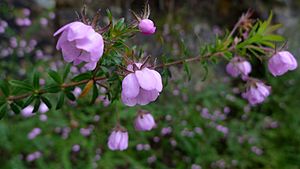River rose facts for kids
Bauera rubioides is a beautiful shrub that has many flowers. You can find it growing in the eastern parts of Australia. People sometimes call it the madder-leaved bauera. This name comes from its leaves, which look a bit like another plant called madder.
Quick facts for kids River rose |
|
|---|---|
 |
|
| Scientific classification | |
| Genus: |
Bauera
|
| Species: |
rubioides
|
| Synonyms | |
|
|
Contents
What Bauera rubioides Looks Like
This plant is a sprawling shrub. It can grow up to 2 meters (about 6.5 feet) tall. It has many stiff branches that grow opposite each other.
Its small leaves are usually pointed. They have 4 to 10 teeth along their edges. Each leaf is about 5 to 15 millimeters long and 2 to 3 millimeters wide.
The Flowers of Bauera
The flowers grow on thin stalks. They stand up straight at first, then droop towards the ends of the branches. Each flower has 6 to 8 sepals, which are like small leaves that protect the bud. These sepals are about 4 millimeters long and also have small teeth.
The most noticeable part of the flower is its petals. In 1804, a scientist named John Sims described them. He said the flowers are usually rose-colored. They often have eight petals, but sometimes one is missing. The petals are shaped like a spear and curve inwards.
Inside the flower, there are many stamens. These are the parts that make pollen. They are shorter than the petals and are creamy white. The plant's flowers do not have any scent.
The name rubioides means "resembling Rubia." This is because the plant looks a bit like the Rubia plant, especially when it is young.
When It Flowers
Bauera rubioides flowers for most of the year. It blooms especially well in spring and summer.
Where Bauera rubioides Grows
You can find this shrub in wet and shady places. It grows in the Australian states of New South Wales, Victoria, Tasmania, and Queensland.
Growing Bauera rubioides
This plant is grown and sold for gardens. It was one of the first Australian plants to be sent to England. People have been growing it there since 1793.
- Adapted from Curtis's Botanical Magazine, Volume 19, page 715.
- You can find more information about Bauera rubioides at the Plantnet, National Herbarium of New South Wales website: Bauera rubioides

